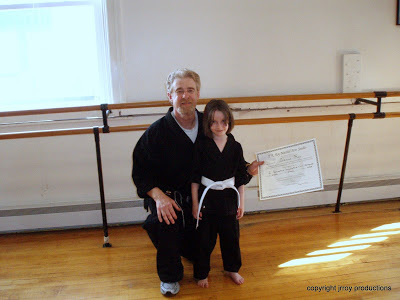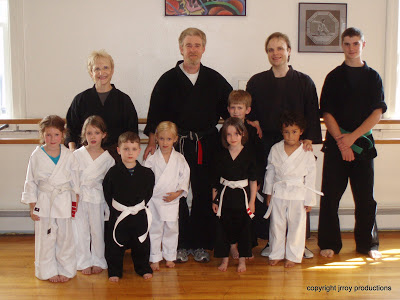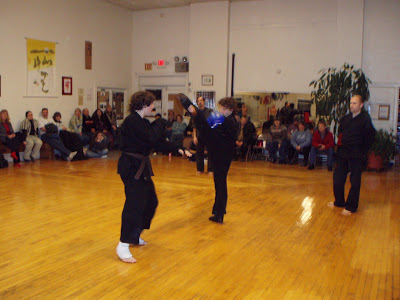On June 30th 2001 Sifu was initiated as a 7th Generation Disciple in Grand Master T. T. Liang’s Yang Style T’ai Chi Ch’uan lineage.I made a pact with myself that day, that I would do a minimum daily practice of at least a ’round’ of T’ai-Chi Ch’uan with warm ups, Standing Meditation and Qigong. Today will make 8 years (2,922 days) that I have been blessed to be physically, mentally and emotionally able to do that practice daily without fail. I am so grateful to my teachers and the knowledge and wisdom that they have shared with me. I’m grateful to them for giving me these truly marvelous health maintenance practices and all of their multifaceted parts; Warm ups, Standing, Qigong, Solo Forms, Weapons Forms, Two Person Sensitivity Exercises, Two Person Weapons training….etc. etc.My main teachers in the chronological order that I met them:Sensei Steve McCabeMaster Paul GallagherMaster Ray HaywardGrand Master Remy PresasAnd all the other teachers that I have trained with over the years that have had a serious impact on my life and my art:Master Ken CohenMaster Leung Key-ChiMaster Zhang JieSifu Jimmy MorrisSifu Paul AbdellaMaster Duan ZhiliangAnd of course many thanks to Grand Master T. T. Liang for the way he handed down the ‘complete system’ and his words of encouragement for my daily practice. The music and Grand Master Liang counting one, two……assists me everyday I encounter difficulty in my daily practice of T’ai Chi Ch’uan…as soon as the music starts and the Master starts to count….It’s like domino’s falling or like flipping a series of internal switches. Inside of me everything slows down and emotionally and spiritually things start to fall into place and I become more peaceful and tranquil inside. The Master helps me to ‘arrive’ at my practice.Over these past 8 years, the daily practice of T’ai Chi Ch’uan has greatly contributed to my “Joi de Vivre”.To all of my teachers ………….[Bow] I show my respect for you is in my daily actions, as I practice and research what you have taught me and reflect and meditate on what you’ve told me. I’m so fortunate to have been blessed with such wonderful teachers and I feel truly grateful. Thank you all! [Bow]J. R. Roy Sifu
Month: June 2009
Fight…Flight ….or …..Freeze!
This post is an amazing story about JG, the1st degree Brown Belt Karate-Do student above, who is practicing defensive Hook Kicks against the stretching bar.JG has studied at JRRMAS since he was a very small child. He has just successfully completed his first year at Deerfield Academy. He was also fortunate to get job at DA this summer as a life guard for the DA pool. Now for the ‘amazing’ part; Last week was JG’s second week as a life guard. He was guarding a 6th grade class swimming in the DA pool. All of a sudden he notices a 6th grader sinking below the surface. Much to JG’s amazement the 6th grader was sinking below the surface without struggling at all! Simply sinking below the surface with limbs limp and the boy was taking water into his lungs. In that very instant of recognition…..Without panicking……or freezing….JG leaped into action and saved the boy’s life. Wow….Amazing!I only hope that the years of training at JRRMAS contributed in some small way to JG acting decisively in that moment of crisis. Correct Martial Arts training is not merely designed to kick and punch others in self-defense but is more accurately designed to give the practitioner that little bit extra that one needs in such a crisis situation. JG’s ability to use the Life Guard Training, the confidence in his own abilities to swim and help others, that enabled him to act decisively, instead of freezing or panicking! You never know if the training is going to pay off until push comes to shove. Lesson 1:In Martial Arts it’s moments of crisis…that the training is designed to prepare you for….So that you…Don’t FREEZE!Don’t PANIC!So that you are able to ACT,able to stay CALM, to stay CENTERED and feel STRONG and CAPABLE….. So that you may act immediately and decisively!In a crisis…Yours or someone else’s life may depend upon your ability to…… act!!SifuJG ….All of us at JRRMAS are very proud of you……That SAVE was the ‘real deal’. Bravo from Sifu!!
Youth American Karate-Do, beginners class, practice side kicks to body shields
Well…I had much difficulty posting today…three failed attempts to upload other videos and 4 hours later, I finally got this one to upload…whew!Lesson 1:The Side Kick is a very powerful kick indeed… it uses two joints, the hip and the knee, unfolding, as in rising from a squat!Initially you when you step up, make sure your supporting foot is pivoted!Then, the best method is to……jump in and….. ‘replace the foot’ To advance, drive the rear knee up,while in the air,drive the kicking knee up,simultaneously land with supporting foot pivoted and kicking foot landing on targetThe advance, the landing and the kick…….. all in one beat!Lesson 2:Remember to drive your kicking knee up highthen, kick from your hip, using your gluts to power-up the kick!Your kicking leg should be straight ‘in line’ with your hip and supporting footMuscle lock the knee …do not lock the bones!Be aware of the ‘Line of Power’!Your supporting foots heel and your kicking foots heel and all that is in between form “One Line” Remember, to keep your balance after the kick has landed and return to a well balanced and defend able position with your hands up!
Little Dragons Class Graduation
Sifu and Little Dragons graduate GR. GR has completed on full year (two semesters) of the Little Dragons program and now has two red stripes on her White Belt.
Harvard Medical School’s Harvard Health Publication calls T’ai-Chi “Medication in Motion”
Harvard Health Publications calls T’ai-Chi “Medication in Motion”!
Tai chi is often described as “meditation in motion,” but it might well be called “medication in motion.” There is growing evidence that this mind-body practice, which originated in China as a martial art, has value in treating or preventing many health problems.
Tai chi is easy to learn and you can get started even if you aren’t in top shape or the best of health. In this low-impact, slow-motion exercise, you go without pausing through a series of motions named for animal actions or martial arts moves. As you move, you breathe deeply and naturally, focusing your attention — as in some kinds of meditation — on your bodily sensations.
Tai chi differs from other types of exercise in several ways. The movements are never forced, the muscles are relaxed rather than tensed, the joints are not fully extended or bent, and connective tissues are not stretched. Tai chi can be easily adapted for anyone, from the most fit to people confined to wheelchairs or recovering from surgery.
Tai chi in motion:
A tai chi class might include these parts:Warm-up. Easy motions, such as shoulder circles, turning the head from side to side, or rocking back and forth, help you to loosen your muscles and joints and focus on your breath and body.
Instruction and practice of tai chi forms:
Short forms — forms are sets of movements — may include a dozen or fewer movements; long forms may include hundreds. Different styles require smaller or larger movements. A short form with smaller, slower movements is usually recommended at the beginning, especially if you’re older or not in good condition.
Qigong (or chi kung):
Translated as “breath work” or “energy work,” this consists of a few minutes of gentle breathing sometimes combined with movement. The idea is to help relax the mind and mobilize the body’s energy. Qigong may be practiced standing, sitting, or lying down.
No pain, big gains:
Although tai chi is slow and gentle and doesn’t leave you breathless, it addresses the key components of fitness — muscle strength, flexibility, balance, and, to a lesser degree, aerobic conditioning.
Here’s some of the evidence:
Muscle strength:
In a 2006 study published in Alternative Therapies in Health and Medicine, Stanford University researchers reported benefits of tai chi in 39 women and men, average age 66, with below-average fitness and at least one cardiovascular risk factor. After taking 36 tai chi classes in 12 weeks, they showed improvement in both lower-body strength and upper-body strength. In a Japanese study using the same strength measures, 113 older adults were assigned to different 12-week exercise programs, including tai chi, brisk walking, and resistance training. People who did tai chi improved more than 30% in lower-body strength and 25% in arm strength — almost as much as those who participated in resistance training, and more than those assigned to brisk walking.“Although you aren’t working with weights or resistance bands, the unsupported arm exercise involved in tai chi strengthens your upper body,” says internist Dr. Gloria Yeh, an assistant professor at Harvard Medical School. “Tai chi strengthens both the lower and upper extremities and also the core muscles of the back and abdomen.”
Flexibility:
Women in the 2006 Stanford study significantly boosted upper- and lower-body flexibility as well as strength.
Balance:
Tai chi improves balance and, according to some studies, reduces falls.
Proprioception:
— the ability to sense the position of one’s body in space — declines with age. Tai chi helps train this sense, which is a function of sensory neurons in the inner ear and stretch receptors in the muscles and ligaments. Tai chi also improves muscle strength and flexibility, which makes it easier to recover from a stumble.
Aerobic conditioning:
Depending on the speed and size of the movements, tai chi can provide some aerobic benefits. But in the Japanese study, only participants assigned to brisk walking gained much aerobic fitness. If your clinician advises a more intense cardio workout with a higher heart rate than tai chi can offer, you may need something more aerobic as well.
For more information on the health benefits of exercise, order our Special Health Report, Exercise: A program you can live with, at www.health.harvard.edu/E.
Harvard Medical School’s Harvard Health Publication, May, 2009
————————————————————————————————-“Tai Chi & Qigong will play an important role in global awakening.”
Eckart Tolle, author of A New Earth (Oprah’s Book Club Pick)
American Karate-Do students sparring at a recent Belt Testing
J. R. Roy Seminar – Saturday July 18th – 1:00-5:00pm – Greenfield, MA
Master J. R. Roy (Sifu) would like to invite all of you looking at the Studio Blog to a:
Master J. R. Roy (Sifu) will be presenting a “Special” blend of material that will include empty hand and weapons training for skill development and sensitivity training.
He will be teach techniques and drills to help your internal energy cultivation and energy release (Fa Jing) with a “Special” training sequence and auxiliry drills. He will also be teaching a blend of joint locks, disarms, baiting and set ups.
This Seminar is appropriate for students at all levels of development, from beginner to the more advanced and for students from any art, external and internal.
This is a rare opportunity to train with Sifu J. R. Roy and learn the “The art, within your art”
Email me to sign up…..today!
Hope to see you there….
Sifu
Modern Arnis, Anyo Tatlo, Empty Hand Form 3
Sifu practices Modern Arnis’s Empty hand form 3 Lesson 1:Modern Arnis is truly a remarkable Martial Art!It combined the Soft and the Hard,the Internal and the External,the straight and the curved.It flows but is punctuated with strength! Lesson 2:Modern Arnis is relaxed, then strengthens when it issues then it returns to relaxed again…..In order to be prepared:to flow, to follow, to control,to be ready,to issue again! Example:The checking hand of a Modern Arnis adept has a very heavy feeling. When practicing Trapping Hands, the checking hand strikes (stregthens), it does not push, but rather it relaxes after impact and listens, in order to flow, follow, control and then position to strike again.”The live hand seeks the path” Prof. Presas
Joint Locking, how to practice it safely and have it contribute to health maintainance
JRRMAS Staff member JK assists Sifu in an explanation of how to correctly practice Joint Lock’s.Lesson 1:These practices can injure your joints if not practiced properly, Always practice with respect for each others range of motion limitations. Injury is guaranteed if you practice to quickly and use too much external muscular force….Instead, concentrate on the exactness of your fulcrum and lever…. and proper body positioning, listening skills and leverage. Speed is good…..up until the point where the slack is taken out of their jointthen you must go slowly giving them time to ‘slap out’Going slowly at the point that the joint lock is ‘activated’ ……will gradually increase the strength and the range of movement in the jointThen instead of injuring the jointsthey are slowly being strengthened and stretched!Sifu
T’ai Chi Ch’uan Dance, Part Three, Issuing Side
JRRMAS Staff member BL and Sifu practice Part Three of Grand Master T. T. Liang’s T’ai-Chi Dance. Sifu is practicing the issuing side.

